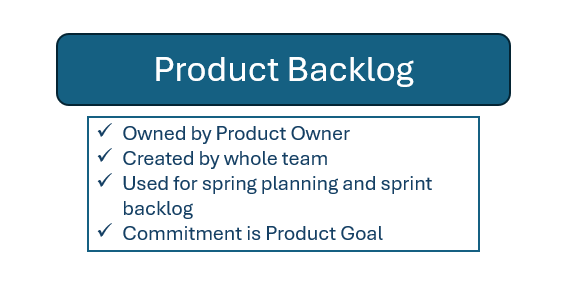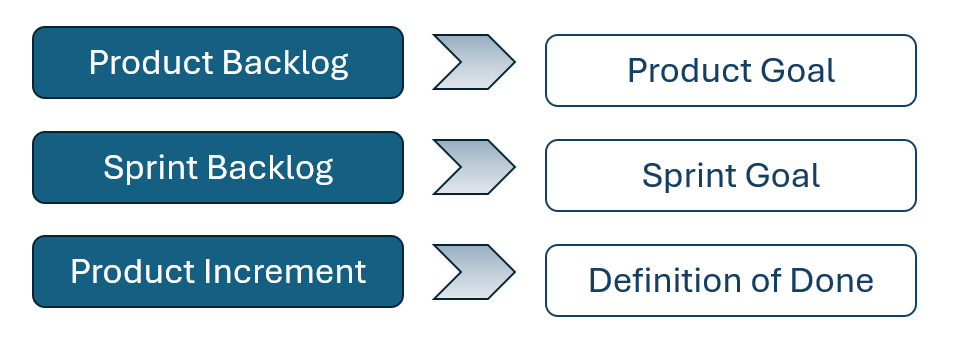Project Management Series: Scrum Artifacts
Scrum is a prominent methodology in Agile project management that highlights adaptability, transparency, and collaboration. It revolves around three main artifacts: the Product Backlog, Sprint Backlog, and Increment, each embodying the values and principles of Scrum. These artifacts are paired with commitments that act as guiding stars, ensuring clarity, focus, and alignment within the Scrum Team and its stakeholders. Let’s explore the meaning of these artifacts and commitments, and how they contribute to project success.

Product Backlog
The product backlog is the ordered list of everything that is known to be needed in the product. It is the single source of requirements for any changes to be made to the product. The product backlog is owned by the product owner, who is responsible for maximizing the value of the product and the work of the development team. The product owner manages the product backlog by:
- Clearly expressing the product backlog items
- Ordering the items to best achieve goals and missions
- Optimizing the value of the work the development team performs
- Ensuring that the product backlog is visible, transparent, and clear to all
- Ensuring that the development team understands the items in the product backlog to the level needed

The purpose of the product backlog is to provide a clear and shared vision of the product and its direction. The product backlog is used by the product owner to communicate the desired features and functionalities of the product to the development team and other stakeholders. The product backlog is also used by the development team to plan and execute the sprints, and by the scrum master to facilitate the scrum events and coach the scrum team.
The commitment of the product backlog is the product goal. The product goal is the long-term objective for the product, which provides a context for the scrum team to plan and deliver increments. The product goal is defined by the product owner and communicated to the scrum team and the stakeholders. The product goal is reviewed and refined throughout the product development process, and it guides the selection and prioritization of the product backlog items.
Sprint Backlog
The sprint backlog is the set of product backlog items selected for the sprint, plus a plan for delivering the product increment and realizing the sprint goal. The sprint backlog is owned by the development team, who is responsible for creating a “done” product increment every sprint. The development team manages the sprint backlog by:
- Self-organizing and collaborating to select the product backlog items that best support the sprint goal
- Decomposing the product backlog items into smaller and more manageable tasks
- Estimating the effort and time required to complete each task
- Updating the sprint backlog throughout the sprint as more is learned
- Tracking the progress and the remaining work in the sprint

The purpose of the sprint backlog is to provide a clear and realistic plan for the sprint. The sprint backlog is used by the development team to focus on the work that needs to be done to deliver the product increment and achieve the sprint goal. The sprint backlog is also used by the product owner to inspect the progress and provide feedback to the development team, and by the scrum master to support the development team and remove any impediments.
The commitment of the sprint backlog is the sprint goal. The sprint goal is the short-term objective for the sprint, which provides a focus and direction for the development team. The sprint goal is defined by the scrum team during the sprint planning, and it describes the value and the outcome of the sprint. The sprint goal is reviewed and evaluated during the sprint review, and it determines the success or failure of the sprint.
Product Increment
The increment is the sum of all the product backlog items completed during a sprint and the value of the increments of all previous sprints. The increment is owned by the development team, who is responsible for ensuring that the increment meets the definition of “done”. The definition of “done” is a shared understanding of what it means for work to be complete, and it is agreed upon by the scrum team and the stakeholders. The development team creates the increment by:
- Implementing the product backlog items according to the sprint plan
- Integrating and testing the product backlog items as they are completed
- Applying the quality standards and the technical practices agreed upon by the scrum team
- Delivering a potentially releasable product increment at the end of the sprint
- Incorporating the feedback and the changes from the previous increments

The purpose of the increment is to provide a tangible and measurable outcome of the sprint. The increment is used by the product owner to inspect the product and adapt the product backlog based on the feedback and the changes in the market. The increment is also used by the development team to demonstrate the work done and receive feedback from the stakeholders, and by the scrum master to facilitate the inspection and adaptation process and ensure the transparency of the product.
The commitment of the increment is the definition of “done”. The definition of “done” is the criteria that must be met for the product backlog items and the increment to be considered “done”. The definition of “done” is established by the scrum team and the stakeholders, and it is reviewed and updated regularly. The definition of “done” ensures the quality and the consistency of the product, and it enables the product owner to decide whether to release the increment or not.
Importance of Commitments
The commitments associated with Scrum artifacts play a crucial role in driving transparency, accountability, and collaboration within the Scrum Team and its stakeholders. By providing clear objectives and standards, these commitments foster a culture of continuous improvement and customer-centricity. They serve as guiding principles that steer the team towards success, enabling them to deliver value iteratively and incrementally.

To sum up, Scrum artifacts and their commitments are the key to Agile project management, helping teams succeed with transparency, direction, and intention. By using these essential elements, teams can optimize their performance, foster creativity, and provide value to stakeholders with certainty and flexibility. Check out our easy to read one pager covering the Scrum Artifacts. (Download here)